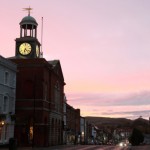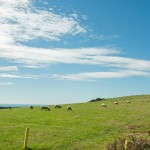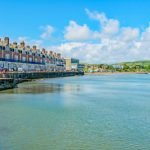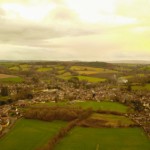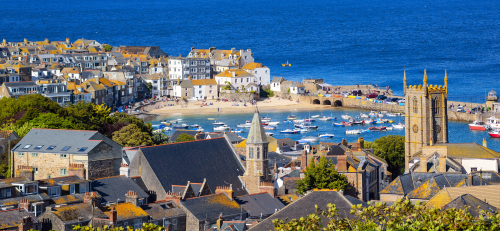
St Ives is a seaside town and port in Cornwall, in the southwest of England. The town lies 8 miles north of Penzance and 13 miles west of Camborne on the coast of the Celtic Sea. Historically, dependent on fishing, the town is now primarily reliant on tourism, notably achieving the title of ‘Best UK Seaside Town’ from The Guardian newspaper, in 2007, and the British Travel Awards in both 2010 and 2011. St Ives is renowned for being at the forefront of the 20th-century British Arts movement. The population of St Ives at the 2011 UK Census was recorded as 11,226.
A Fleeting History
The area around St Ives is believed to have been settled as early as the Bronze Age. The surrounding moors with their ancient field systems and numerous megalithic sites, bear testament to the premise. However, the origin of the settlement of St Ives is attributed to the mid-5th century arrival of the Irish Saint la of Cornwall. The parish church bears her name, from which the name of St Ives is derived.
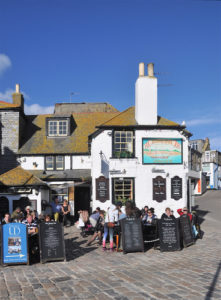
The Sloop Inn, St Ives – one of Cornwall’s oldest pubs
The Sloop Inn, which lies on the wharf was a fisherman’s pub for many centuries and is dated to “circa 1312”, making it one of the oldest inns in Cornwall. During medieval times, fishing was important to St Ives with eventually becoming one of the most important fishing ports on the Cornish coast. The date of the town’s original pier construction is unknown but the first written reference to it was made in 1478 by William Worcester is his ‘Itinerary’. Between 1766 and 1770, the town’s pier was re-built to a design by John Smeaton.
In 1597, two ships of the invading Spanish Armada, which had separated from the main fleet, took shelter from an impending storm at St Ives. The ships were seized by the English warship Warspite, whereby information extracted from the captured crew was instrumental in the eventual defeat of the Spanish by the English Navy.
The 1800s
By the mid-18th century, St Ives had become one of the four principal fishing ports of Cornwall, along with Falmouth, Fowey and Penzance. The main catch was pilchards, the majority of which were export to Italy and Meditteranean Europe.
In 1840, a lifeboat was stationed in the town for the first time. And in 1877, the branch line between St Ives Bay and St Erth, part of the Great Western Railway, was completed. This brought in a horde of Victorian holidaymakers, experiencing the seaside for the first time. The town’s newfound wealth saw it expand relatively quickly during the latter part of the 19th century.
In 1920, Bernard Leach and Shōji Hamada set up the Leach Pottery in St Ives. Leach continued working in the town up until 1972, and his pottery remains in operation to date. In 1939, world-renowned artists Ben Nicholson, Barbara Hepworth and Naum Gabo had all settled in the town, paving the way for the town’s robust bohemian community that was to follow. In 1980, ‘the Tate’ bought up the Barbara Hepworth Museum and Sculpture Garden. And in 1993, the world-famous gallery opened ‘Tate St Ives’. The town continues to attract a wealth of contemporary artists who choose to take up residence there.
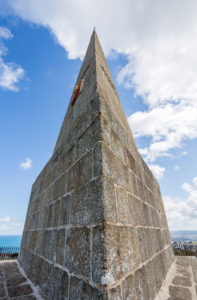
Knill’s Steeple – St Ives
The Knill Ceremony
The ‘Knill Ceremony’ is a local custom that takes place every five years on July 25th (St James’ Day) in St Ives. The offbeat ceremony honour’s the wishes of a local dignitary and former eccentric town mayor, John Knill. He built a mausoleum for himself in the town, which is now known as ‘Knill’s Steeple’. He requested in his will that a procession be made in the town every 5 years. He stated that a fiddler, ten girls all aged under 10, dressed in white, who were daughters of either tinners, fishermen or seamen, and two widows of the same professions, all of whom must from St. Ives, should lead a gathering up to the site of the Steeple. Once there, the girls should dance around the steeple for 15 minutes, while all those assembled should sing the hundredth psalm “All people that on earth do dwell”. The first ceremony was held in 1801, which John Krill himself bizarrely attended. The citizens of the town still honour Krill’s wish to this day. Ironically, Knill died in 1811 at his chambers in Gray’s Inn Square, London and ended up being buried in the nearby St Andrew’s Church, Holborn.
St Ives In The Modern Era
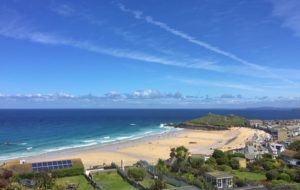
Porthmeor Beach, St Ives – has Blue Flag status!
St Ives greatest natural assets, which is no doubt instrumental in drawing tourists to the town, are its array of stunning white sandy beaches. Set at the eastern end of the Island is Porthgwidden Beach. Overlooked by the Tate Gallery is the large Porthmeor beach, which is locally famed as a surfer’s beach. Directly in front of the town is Harbour Beach, with Porthminster Beach being nearby. A short way along the coast is the long, sandy Carbis Bay beach.
St Ives also holds a fair number of events throughout the year, which is also a big draw for tourists. Held on the first Monday of February, is the local custom of ‘Hurling the silver ball’. It kicks off in the mid-morning by the Mayor throwing the ball from the grounds of the Parish Church of St Eia. It is then thrown from person to person, through the streets of the town towards the beach. At noon, the game ends and culminates in person left holding the ball receiving a small prize.
Literature Festival
The St Ives Literature Festival is an annual week-long event, held in May, which sees open-air performances held in Norway Square, and talks, workshops and live music at the St Ives Arts Club. In September, the two weeks September Festival is held in the town, with over 200 events featuring music, dance, poetry, crafts and theatre, taking place. In recent times, the town has become a bit of a ‘Mecca’ for New Year’s Eve celebrations which sees thousands of revellers in fancy dress packing the streets.
In the relatively recent past, St Ives has become somewhat notorious for its exotic ‘shark’ sightings. In 2007, there was a reported sighting of a great white shark, just off the town’s shores, although experts said it was much more likely to have been a mako or a porbeagle. On 14 June 2011, a boat was reportedly attacked by an oceanic whitetip shark. However, the Shark Trust said that the chances of that shark species being in British waters were “very small”. On 18 July 2017, it was reported that a blue shark was seen in the waters close to the harbour. On 16 July 2018, another blue shark was spotted, this time, in the harbour.
St Ives is twinned with Camaret-sur-Mer in Brittany, France and has friendship agreements with Laguna Beach, California and Mashiko, Tochigi, Japan.
Getting To St Ives
By Road
Despite its relatively remote location, getting to St Ives by road is relatively easy. Just follow the M5 motorway towards Exeter until you reach the A30. Stay on the A30 all the way to the Hayle By-pass. Turn right at the St Erth Roundabout and head for Lelant. At Lelant keep on the A3074 St Ives Road for 3.5 miles before arriving at St Ives.
By train
St Ives railway station is linked to the Paddington, London to Penzance mainline service to Cornwall, via the branch line from St Erth. The branch line operates a service every 30 mins throughout the day, with a 10 minutes journey time. The branch line also links St Ives to nearby Carbis Bay and Lelant.
By Bus
The town has a regular bus service operated by National Express to/from London Victoria, Heathrow, and many other places in Britain. First Kernow operates a local bus service buses connecting St Ives to nearby towns and villages, such as Zennor, Penzance and Truro.
By Air
The nearest airports to St Ives are Newquay and Land’s End, near St Just.
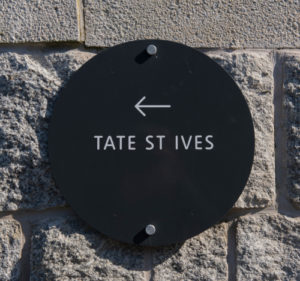
St Ives has one of only four Tate Galleries in the UK
Did you know?
- The famous Sloop Inn, which overlooks the harbour in St Ives, is one of the oldest inns in the UK, dating back to around 1312
- The branch railway line between St Erth and St Ives is reputed to be one of the most picturesque train rides in the country
- Tate St Ives is one of only four Tate Art Galleries in the UK, the others are Tate Liverpool, Tate Britain and Tate Modern, both in London
- Of the eight beaches in Cornwall that have the coveted Blue Flag status, three of them are in the St Ives area; Carbis Bay, Porthmeor and Porthminster
Things to see and do!
- The Barbara Hepworth Museum and Sculpture Garden – offers a unique insight into the work and life of one of Britain’s most important 20th-century artists
- The St Ives Bay Line – take a train ride on one of the country’s most scenic railways between St Ives and the Tamar Valley Line
- Escape Time – offers a live escape room game experience for families, friends, hen parties, stag parties and corporate events
- ArtSpace Gallery – presents quality paintings, prints and 3-D work, which are sold to both national and international collectors
- West Penwith AONB – walks featuring stunning scenery in an ‘area of outstanding natural beauty’ (AONB) along Cornwall’s most westerly coastline
- Treasure Trails – 60 self-guided themed ‘Treasure Trails’ in great locations around St Ives and throughout Cornwall
- Penwith Gallery – bohemian area hidden in the cobbled, winding backstreets, displaying works of some highly regarded contemporary British artists
Where to Stay?
There’s something in the St Ives area to suit most tastes and budgets. A broad indication of prices for commonly available accommodation in St Ives is:
B & B/Guesthouses: £60 – £80
Standard Hotels/Inns: £80 – £100
3/4/5 Star Hotels: £100 – £200
Holiday Home/Apartments: £90 – £120 pppn (for max occupancy)
Take the quiz

